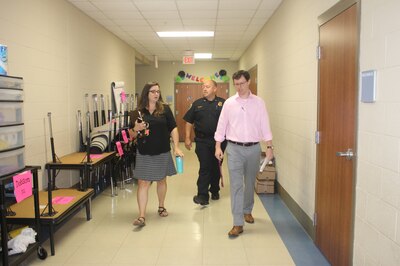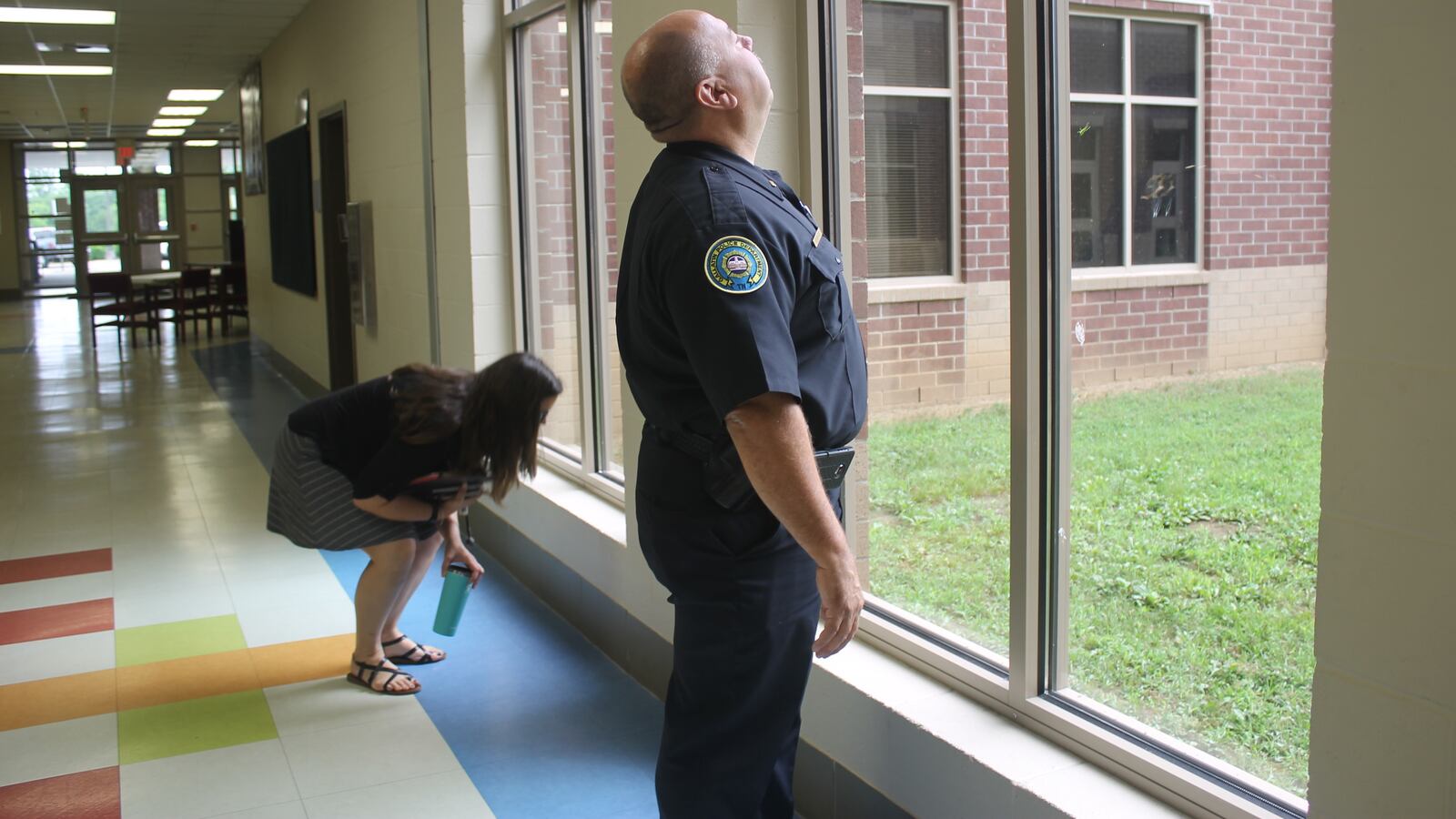Balancing a clipboard in one hand and a coffee tumbler in the other, Katie Brown bends down to inspect a window pane in the hallway of a 10-year-old Tennessee school building.
The glass is shatter-resistant. Check.
Down the hall, Lt. Billy Vahldiek opens an outside exit door and then watches as it latches and locks properly. Check.
Earlier that morning, both Brown and Vahldiek circled the elementary school’s outside perimeter to make sure lighting is adequate, signage is clear, and landscaping doesn’t create blind spots where an intruder could hide.
The pair — one a school safety coordinator, the other a police officer — are teaming up on this day in Sumner County, north of Nashville, to walk through several schools and review security protocols with their principals as part of a statewide review.
“A lot of these schools were built post-Columbine, and some of them are post-Sandy Hook, but none of them are post-Parkland,” said Vahldiek, a Gallatin police officer, chronologically listing three of the nation’s most horrific school shootings.
Aging school facilities and heightened safety concerns are the prime drivers behind Tennessee’s sweeping summertime inspection of all 1,800 of its public school campuses. Gov. Bill Haslam ordered the unprecedented assessment in March following an intruder’s fatal shooting rampage at Marjory Stoneman Douglas High School in Parkland, Florida.
The state’s goal is to identify vulnerabilities that could put Tennessee students and staff at similar risk — and to inform districts how they should use $35 million in safety grants in the months ahead.
Tennessee is among states that responded to Parkland by stepping up their upcoming budgets for thwarting potential attackers. This spring, Haslam and the Legislature doubled to $10 million the amount of recurring annual safety grants — and also provided a one-time investment of $25 million. A share of the money will become available to all 147 districts beginning in July based on Tennessee’s school funding formula — but only after the school systems provide the state with safety inventories of all of their schools.
"It’s a massive undertaking. It’s the first time we’ve ever looked at every school in Tennessee like this."
Mike Hermann, Tennessee Department of Education
“It’s a massive undertaking. It’s the first time we’ve ever looked at every school in Tennessee like this,” said Mike Hermann, who is helping to coordinate the review in behalf of the state Education Department.
“Our work is definitely cut out for us this summer,” added Commissioner David Purkey, whose Safety and Homeland Security department is spearheading the initiative. “But there’s a sense of urgency. We want to get it all done by the start of the school year, at least that’s our goal.”
As of this week, about a third of the inspection reports had been submitted — on pace with the state’s timetable. In mid-July, Tennessee will begin accepting applications for the extra spending money.
Most of the one-time grants are expected to further harden school campuses with improvements like upgraded security cameras, fixing or replacing broken locks or outdated doors, and beefing up front entrances. The smaller annual funding could be tapped to hire law enforcement officers to police some campuses, though the money is a drop in the bucket toward providing coverage for every school. There’s also opportunity to invest in mental health services if that’s identified as a local priority.
Five things to know about school resource officers in Tennessee
Bill to arm some Tennessee teachers with handguns dies
The money will only go so far. Still, officials believe the safety review lays the groundwork for next steps.
“It’s an excellent opportunity for schools to make an honest appraisal of where they are with security,” Hermann said. “And we’re going to have a much clearer picture of where we are statewide so that future action by the next governor and General Assembly can be based on a higher level of information.”
The reviews are conducted by local teams who participated in regional trainings provided by the state Safety and Homeland Security Department. Comprised of school personnel and local law enforcement, each two-person team follows an 89-point checklist of risks and precautions based on national standards developed by the U.S. Department of Homeland Security.

Depending on the building’s age and size, each review usually take two to three hours as inspection teams meet with the principal and inspect the physical facility. Can a school control access to the building? Do all staff wear photo identification badges on campus? Do teachers keep their classroom doors locked?
“The days of propping open doors on a pretty day are gone,” said Brown as she and Vahldiek went through the checklist during one inspection.
The teams also document the availability of personnel for security and for student support services such as school psychologists, as well as relationships with local law enforcement and healthcare providers. Finally, they submit their reports to the state and include copies of each school’s emergency plans and its drill logs from the previous year.
Unfortunately, summertime does not lend itself to seeing a school on a typical school day. For now, the buildings are mostly empty of students and staff as classrooms are painted, floors are waxed, and maintenance performed. But Brown views school break as a good time to look at the nitty-gritty details and to have thoughtful, unrushed conversations with school leaders that should trickle down to faculty and staff.
“We absolutely are taking this seriously,” said Brown, who is coordinating 46 reviews for Sumner County Schools.
“Most things on the checklist are not requirements or codes; they’re recommendations and best practices,” she said. “But this raises our awareness. It reinforces the good things we’re already doing. And it will inform how we use the safety grants.”
Editor’s note: This story does not name the school being inspected as a condition of Chalkbeat’s reporter shadowing the review team.

